Project Profiles in British Columbia
Learn more about some of the projects in British Columbia by selecting a community name:
- 100 Mile House
- Abbotsford
- Anmore
- Barriere
- Burnaby
- Canal Flats
- Chetwynd
- Chilliwack
- Coldstream
- Courtenay
- Cranbrook
- Dawson Creek
- Delta
- District of Lake Country
- Elkford
- Enderby
- Fernie
- Fort Nelson
- Fort St. John
- Gas Tax Fund Project in François Lake
- Fraser Lake
- Fraser-Fort George
- Harrison Hot Springs
- Invermere
- Kelowna
- Kimberley
- Kootenay Boundary Regional District
- Langford
- Langley
- Lillooet
- Maple Ridge
- Nanaimo Regional District
- New Denver
- North Saanich
- North Vancouver
- Peace River Regional District
- Penticton
- Port Alice
- Port Renfrew
- Pouce Coupe
- Prince George
- Princeton
- Qualicum Beach
- Radium
- Regional District of Mount Waddington
- Regional District of Okanagan-Similkameen
- Revelstoke
- Richmond
- Saanich Peninsula
- Squamish
- Summerland
- Surrey
- Terrace
- Tumbler Ridge
- Valemount
- Vancouver
- Victoria
- West Vancouver
- Whistler
- Williams Lake
Providing safe water to our communities
Project location: Anmore
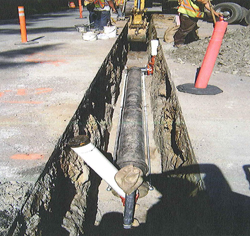
In Metro Vancouver's second-smallest community, water works had become a pressing issue. Serving a population of almost 2,000 people, Anmore's distribution system was getting old and unreliable, and was too small to accommodate future growth.
In an effort to extend the life of the system, the village obtained a financial contribution from the Communities Component of the Building Canada Fund to replace and twin the water main near Sunnyside and East roads.
The more efficient, looped distribution system has improved water quality by reducing stagnant water in the lines and is delivering increased water pressure in homes and at fire hydrants.
Remote monitoring technology makes managing the water system more efficient too by eliminating the need for site visits to evaluate system performance.
Federal contribution: $178,428
Better water quality

Project location: 100 Mile House
Located in the South Cariboo region of the central interior of British Columbia, 100 Mile House residents and a growing number of tourists enjoy the year-round recreational benefits of the area's many lakes and wetlands that form part of the Fraser River watershed.
Recognizing the need to plan for future municipal growth and the increasing tourist trade, municipal leaders applied for $124,000 from the federal Infrastructure Stimulus Fund to ensure the continued reliability of the town's drinking water treatment facilities.
The District of 100 Mile House installed two ultraviolet disinfection units, relocated an existing water pump, and made necessary repairs and adjustments to the water treatment building.
Mayor Mitch Campsall points out that "without the vision and ongoing commitment to community renewal and economic stability being championed by the federal government"
such infrastructure projects would not be possible for small communities to undertake. Now, nearly 2,000 residents of 100 Mile House and a growing number of tourists are assured of high-quality drinking water.
Federal contribution: $124,000
Greener transportation
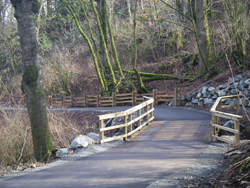
Project location: Abbotsford
The Abbotsford Discovery Trail near Willband Creek is six kilometres longer thanks to financial support from the federal Infrastructure Stimulus Fund.
The Discovery Trail will ultimately be a 35.5 kilometre, multi-purpose, all-season corridor linking neighbourhoods and connecting facilities such as schools, civic buildings, parks, churches, with commercial and natural areas. Its goal is to promote active, healthy living and greener forms of transportation.
Designed to be completed in five sections, the opportunity to apply for funding under the federal Infrastructure Stimulus Fund was timely for the Town of Abbotsford. The third phase of the Trail's development, the new six-kilometre section near Willband Creek was made possible through the $469,913 federal investment, matching provincial funding and a massive community fund-raising drive.
About three metres wide, the Discovery Trail provides Abbotsford families with a paved outdoor setting for walking, running, rollerblading and bicycling, and promotes healthier alternatives to automobile use. Accessible to all members of the community, the Trail includes grades to challenge all fitness levels, picnic and wildlife viewing areas, scenic ponds and forested vistas.
Mayor George W. Peary calls the Discovery Trail a very important project that will encourage fitness, reduce air pollution and create a unique identity for the town. "I'm proud to see a community project that inspires tremendous generosity and volunteer spirit. These trails are [...] a truly lasting legacy for our community."
Federal contribution: $469,913
Major improvements to traffic circulation

Project location: Abbotsford
It was the highest transportation priority project for the City of Abbotsford: replacing the 50-year-old McCallum Road interchange over the Trans-Canada Highway with one that would meet the realities of today's traffic volumes and speeds. Congested on — and off — ramps had increased development in the area, and traffic to key amenities along McCallum Road — a sports arena, hospital, and the airport — had created a high-accident zone.
The City, Province and Government of Canada all contributed to the project, which involved creating longer deceleration lanes and changing traffic patterns to ensure peak-volume traffic didn’t back up onto the highway. New sidewalks and bike lanes, as well as a park-and-ride lot, were also constructed to promote public transit and alternative, "greener" travel.
The federal contribution to the interchange project came from the Infrastructure Stimulus Fund.
Federal contribution: $8,333,333
Building up Barriere
.jpg)
Project location: Barriere
The District of Barriere is 66 kilometres north of Kamloops. Although blessed with ample outdoor recreational opportunities, the community has struggled to attract tourists and development since forest fires severely damaged the area in 2003. Barriere has since made significant efforts to enhance its community infrastructure and restore its draw for tourists.
Barriere has a population of less than 2,000 and only a small budget for new infrastructure investments. According to the district's Chief Accounting Officer, Colleen Hannigan, two recent green space enhancement projects could not have gotten off the ground without assistance from the federal government's Infrastructure Stimulus Fund.
A new multi-use pathway along a key artery for bikes, pedestrians and roller bladers is now in place. As a first phase of longer-term plans to extend the trail throughout the community, it supports British Columbia's ActNow physical fitness promotion program. Where sidewalks were a rarity, "this multi-use greenway provides a safe alternative for children, seniors and those with disabilities to get around our community,"
commented District Mayor Mike Fennell.
Work is also complete on a new field house in the main community park. It features much-needed storage space, washrooms and a first-aid room. The new band shell helps attract entertainment and regional visitors to the park.
Residents and tourists alike can now enjoy these infrastructure enhancements.
Federal contribution: $193,667
Keeping on top of water infrastructure renewal

Project location: Burnaby
Burnaby, British Columbia's third-largest city, is located immediately east of Vancouver. The community is well served by a municipal water system but it needs ongoing investments to keep it operating optimally in the face of continuing growth.
Municipal officials recognized that addressing water infrastructure needs before major problems develop could save the community ongoing maintenance costs and minimize service interruptions. By evaluating local water usage patterns, geographic layout and historic failure patterns, the city's engineering department identified the sections of its aging infrastructure that most needed renewal.
With support from the federal Infrastructure Stimulus Fund, 25 priority locations received the upgrades they needed.
This work will go a long way in helping ensure Burnaby residents continue to enjoy a reliable, high-quality water supply.
Federal contribution: $2,470,000
Promoting resident safety and health

Project location: Canal Flats
Situated at the southern end of Columbia Lake, Canal Flats, British Columbia is a gateway into the world-renowned recreational areas of the Kootenay River Valley. But in the town itself, the lack of sidewalks impeded pedestrian traffic, including recreational activities that promoted good health.
Recognizing the need to encourage alternative and healthy means of travel, the Village of Canal Flats applied for funding to undertake its first-ever major project: a 2.5-km paved walkway linking the school, community hall, seniors hall, arena and commercial areas of the village.
With over $100,000 from the federal Infrastructure Stimulus Fund, and support from the province and the municipality, Canal Flats now has a safe walking path for the village's 800 residents and visitors alike.
Children can walk or bike to school safely away from motorized traffic, and seniors have a smooth paved surface for a little outdoor exercise and fresh air.
Mayor Bruce Woodbury calls the walkway a "significant safety improvement" that also just happens to promote the good health of his community.
Federal contribution: $101,333
Environmental and economic benefits realized

Project location: Chetwynd
Initially a gravel road with narrow shoulders, 53rd Avenue in Chetwynd needed a facelift. An important feeder artery to BC Highway 97, which runs through town toward Prince George and Alaska to the west and Dawson Creek to the east, 53rd Avenue facilities included a mix of services for motorists on Highway 97 like motels and gas stations, and for area residents such as a church and places of employment. Subdivisions were also beginning to branch off of 53rd Avenue.
The District of Chetwynd reconstructed and widened part of 53rd Avenue, building a new sub-base, adding drainage, curbs and gutters, and asphalt. The federal contribution of $198,873 from the Communities Component of the Building Canada Fund helped make this project possible.
With the widened shoulders and smooth road surface, cyclists and pedestrians can now safely use the street. The asphalt surface also means less wear and tear on vehicles, and silt from the previously graveled road no longer runs into nearby ditches with every precipitation and thaw event, eventually ending up in the local water table.
The paved surface also improves access to the businesses and services along the street – something long-distance truckers and motorists on Highway 97, and local residents and businesses greatly appreciate.
Federal contribution: $198,873
Improved pedestrian safety in Chilliwack
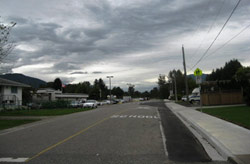
Project location: Chilliwack
Thanks to a contribution from the federal Infrastructure Stimulus Fund, the City of Chilliwack has built some much-needed sidewalks to improve public safety and encourage active living.
Many streets in Chilliwack lacked sidewalks and other standard features that contribute to pedestrian safety. This means residents had to use road shoulders to get around on foot, which can increase the risk of vehicle-pedestrian collisions and deter walking.
To help address this issue, the City identified four major roads serving schools and other key community buildings as high priorities for sidewalk upgrades.
The improvements have increased safety for residents, including students walking to and from school, and boosted residents' confidence in leaving their cars at home while trying more environmentally-friendly, and healthy alternatives.
Federal contribution: $51,383
Keeping business moving with smoother traffic flow
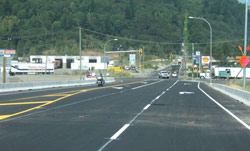
Project location: Chilliwack
As one of the busiest shipping corridors in the Fraser Valley, Lickman Road, near the Trans-Canada highway in Chilliwack, has a very high traffic volume. This had led to recurring traffic congestion and the third worst collision rate in the City.
The Lickman Road Interchange project, supported by the federal Infrastructure Stimulus Fund, has now made changes to the roadway to address these issues.
The project included installing a new traffic signal system for the busy off-ramp and dedicated turn lanes at the existing traffic signal. Workers also extended the northbound right-turn lane to the off-ramp, and applied an overlay of highly durable concrete to reduce long-term maintenance. Dedicated bike lanes were also added to increase safety.
The many nearby businesses are benefiting greatly from the smoother traffic flow along this route. For the freight industry, a vital component of British Columbia's economy, it also means getting goods and services to their destinations in better time.
Federal contribution: $450,000
Sustainable landscaping that promotes physical activity

Project location: Coldstream
A park that had been on a lot of wish lists for a very long time is now a reality, with the help of $187,500 from the federal Infrastructure Stimulus Fund.
Middleton Mountain dominates the landscape for most residents in the northern part of BC's famed Okanagan Valley. Many people can access the mountain area directly from their own homes in the surrounding municipalities of Vernon, Coldstream and Lavington.
A trail looping around Middleton Mountain now provides an estimated 4,000 regular users with a safe, natural outdoor setting for physical activity. The easy access also helps promote a more active lifestyle for the 77,000-plus residents in the region. Local businesses hope it helps promote tourism.
The funding also supported a sports field and improved accessibility to the trail area for people with disabilities.
Incorporating sustainable landscaping and an enhanced wildlife habitat, the park was long overdue in many people's estimations. Mayor Jim Garlick of Coldstream calls the new recreation area a "much needed park facility"
and a "wonderful improvement to the area."
Federal contribution: $187,500
Restoring a link to Courtenay's past
Native Sons Hall

Project location: Courtenay
The historic Native Sons Hall in Courtenay, BC, about 100 km north of Nanaimo on Vancouver Island, has a new lease on life, thanks to a $650,000 contribution through the federal Infrastructure Stimulus Fund.
Built in 1928 as Courtenay's recreation centre, the hall is the largest free-span log building in British Columbia. After hosting weddings, dances, concerts, community events and farmers' markets over the years, it recently became home to the Courtenay and District Museum.
The renovations have preserved the hall's unique character while bringing it up to modern standards. Work included improving the building's energy efficiency, adding new wiring to permit remote viewing of cultural events, and landscaping.
"This funding [has helped] rejuvenate the facility and ensured the Native Sons Hall remains an ideal setting for local events for many years to come,"
said Courtenay Mayor Greg Phelps.
The hall's location on the 10-kilometre "riverway walk", close to the Sid Williams Theatre and the Florence Filberg Centre, creates many opportunities for events that will draw visitors and create spinoff economic benefits for the area.
Federal contribution: $644,566
Taking the waste out of wastewater
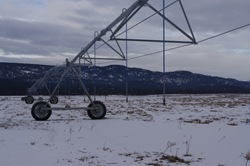
Project location: Cranbrook
People have been using wastewater as a nutrient-rich medium to irrigate their crops for centuries. In the City of Cranbrook, this practice is being revitalized with a sophisticated new wastewater spray irrigation system.
Cranbrook has already updated a large portion of its wastewater system thanks to financial support from the federal Infrastructure Stimulus Fund. To complete the four remaining phases of the planned improvements, the City is using an allotment from the federal Gas Tax Fund, created to help communities realize public infrastructure projects that lead to more positive environmental outcomes.
The final phase of work includes installing aeration systems, completing a transfer pipeline, and improving the transfer pump and irrigation pump station. By re-using wastewater for crops, the need to discharge wastewater into the East Kootenay River will be greatly reduced and often eliminated. This will also significantly decrease the water demands of the farming community.
Cranbrook is one of only a few jurisdictions in Canada to use this innovative approach and is considered a "Centre of Excellence" for reclaimed water use. Their new irrigation system will lead to a cleaner environment, less energy consumption, and lower operating costs.
Federal contribution: $4,815,000 from the Infrastructure Stimulus Fund + Gas Tax funding.
Safety concerns addressed
Storm water control improved

Project location: Dawson Creek
U-turns had become an all too familiar occurrence on 92 Avenue in Dawson Creek. Motorists would discover barriers and the street closed yet again due to water erosion underneath the roadbed that had made the roadway unsafe even for pedestrians.
Realizing repairs would be costly, the City of Dawson Creek applied for assistance from the federal Infrastructure Stimulus Fund and was awarded $257,333. Upgrades include new storm water drainage, a new watermain and culvert, and replaced roadbed in the damaged section of 92 Avenue.
The upgrades improve water flow and reduce the impact of erosion on both the roadbed and the watermain system. They also stop excessive runoff from entering Dawson Creek untreated or flooding neighbouring properties.
Located in the north end of Dawson Creek, 92 Avenue is a major arterial connector. The street connects a nearby school and residential area and is served by public transit. The upgrades have addressed safety concerns for everyone using the street. The improvements also help position Dawson Creek to deal with future growth.
Federal contribution: $257,333
New home for community archives
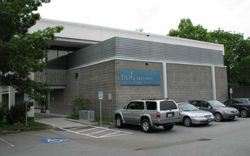
Project location: Delta
The Delta Museum and Archives Society now has a safer, climate-controlled place to store their delicate collection of historical documents and artefacts.
The new state-of-the-art storage facility on the first floor of Delta's former courthouse ensures these records are properly preserved for future generations. Energy efficiency upgrades mean the building now meets the LEED Silver standard.
The museum's collection contains over 100 years of municipal records, such as diaries, ledgers, correspondence and meeting minutes. The inventory also includes newspapers dating back to 1902, over 20,000 photographs and 800 maps.
The new location is ideal both for storage and access. It is well served by bus routes, easy to get to for pedestrians and cyclists, and accessible to people with mobility impairments.
The new archive facility has also freed up space at the museum for more exhibits and educational programs, which will help draw more visitors.
The Government of Canada provided $225,000 to the project through the Infrastructure Stimulus Fund.
"The federal and provincial governments' support has been instrumental in the development of the new Delta Archives,"
commented Mayor Lois Jackson. "The Infrastructure Stimulus Fund enabled us to provide [the community] with a first-class facility … that will house key documents vital to the preservation of Delta's long and rich history."
Federal contribution: $225,000
Waste not, want not

Project location: District of Lake Country
The District of Lake Country encompasses four communities and is located in the sunny Okanagan Valley. In the past, the District relied on a mix of gas and coal to generate energy, but with increasing concerns about the environment, had been looking for ways to lower their carbon footprint and embrace renewable energy.
Over several years, community groups such as the local Okanagan Indian Band Council, municipal administrators, government organizations and others collaborated to bring a new hydroelectric generating station to the region. What started as a distant vision is now a reality thanks to financial support from the federal Gas Tax Fund.
The new facility has not only reduced the District's dependency on fossil fuels, it is also producing new sources of energy and revenue by harnessing excess hydroelectricity. "This has been a great exercise in using existing water infrastructure to provide a clean energy revenue source that was otherwise expended as heat and noise,"
commented Lake Country Mayor, James Baker.
The Clean Energy Association of British Columbia agreed, selecting the station as "Project of the Year" in 2011 for its innovative use of existing infrastructure and the solutions-oriented leadership demonstrated at the local level.
Access to Canada's wilderness
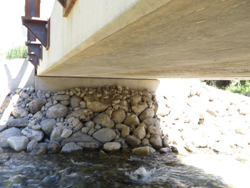
Project location: Elkford
The Elk River Forest Service Road provides backcountry enthusiasts from all over the world with access to Elk Lakes and Height of the Rockies provincial parks. Both are located in the western ranges of the southern Rocky Mountains near the Alberta border. Once there, adventurous souls can enjoy some of British Columbia's richest backcountry experiences.
Icefalls, mountain lakes, cliff faces and pristine forests are just some of the features of this recreational haven. Several rustic cabins are maintained year-round to provide a comfortable base for adventurers who arrive for the unparalleled biking, hiking, snowshoeing, ice-climbing, skiing and mountaineering.
The forest service road, which crosses the Elk River north of Elkford, was served by a bridge that was narrow and no longer safe.
With support from the Infrastructure Stimulus Fund, the bridge has now been replaced. Recreational enthusiasts and motorists who use this remote road year-round will now have a safer, more durable bridge to cross. Forestry and fire crews as well as the local community will benefit from the new bridge.
Federal contribution: $50,970
Federal Gas Tax Fund helps lower building heating costs
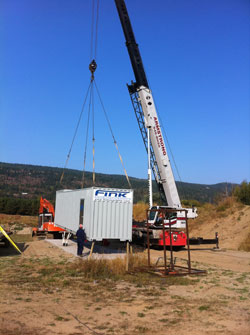
Project location: Enderby
Located at the top of the Okanagan Valley, one of British Columbia's most cherished and beautiful natural environments, the small City of Enderby is striving to become a more sustainable community. Surrounded by stunning features like the Enderby Cliffs and the Shuswap River, advancing the City's green initiatives is a top priority.
Enderby recently used a portion of its annual federal Gas Tax Fund allocation, combined with municipal funding, to install a bio-energy heating system.
By using wood waste from the surrounding mills that would otherwise be sent to a landfill or just burned on site, the new system is currently heating the community's public works shop, parts of the sewage treatment plant and the local kennel.
There are other big benefits from the project. The City expects to lower its greenhouse gas emissions by more than 250 tonnes per year and save more than $85,000 in annual heating costs.
"The completion of the bio-energy heating system marks the beginning of an exciting future for the City of Enderby,"
said Mayor Howie Cyr. "The system will reduce greenhouse gases in the city while at the same time dramatically reducing operating costs. It also promises, through future expansion, to extend these benefits further into the community."
With system expansion plans already being discussed, Enderby citizens can count on additional steps to protect the environment and make municipal operations more economical.
Improving highway safety through the Rockies

Project location: Fernie
Highway 3, between Fernie and Sparwood, has long been recognized as an essential regional route. It runs adjacent to Crowsnest Pass and is a well-used shipping corridor connecting British Columbia with the rest of the country.
Like many of the roads and highways passing through the Canadian Rocky Mountains' passes, this highway can be treacherous. Rugged terrain and unpredictable weather often combine to create hazardous road conditions. Heavy forestry and mining vehicles that frequent the route can also compromise safety and lead to frustrating delays.
To help keep traffic and goods moving smoothly, the provincial government made it a priority to add passing lanes along the highway.
Thanks in part to funding support from the Government of Canada's Infrastructure Stimulus Fund, the project is now complete. The new lanes are increasing the safety and efficiency of the provincial highway network throughout the region.
Federal contribution: $3,500,000
Highway improvements support northern economic development

Project location: Fort Nelson
The Town of Fort Nelson is located in BC's Peace River region east of the Northern Rocky Mountains. Rich in natural resources, the area's economy was traditionally driven by forestry, but now pivots on oil and natural gas development, as well as a growing tourism industry.
Fort Nelson is anticipating accelerated growth due to major investments being made by a number of companies in shale gas development. Industrial development means heavier traffic and more wear and tear on road infrastructure.
To ensure they're prepared to keep increasing industrial traffic moving smoothly, the Town used a federal financial contribution from the Infrastructure Stimulus Fund to improve a local transportation corridor.
More than 25 kilometres of Highway 77 between Deasum Creek and the Northwest Territories has a new hard surface over a stronger underlying base. This will better protect the road against the damage that heavy vehicles cause. The improvements make travel faster, safer and more comfortable, including for the more than 140,000 tourists who drive through the area each year.
The federal government invested in this project as part of Canada's Economic Action Plan, which was launched in 2009. The investment reflects the Government's commitment to supporting economic development in Canada's North.
Federal contribution: $2,048,975
Enhancing green spaces

Project location: Fort St. John
The new Enerplex in Fort St. John has become the hub for recreational and sports activities for the Peace River district of northeastern British Columbia. Indoor facilities include two regulation-size hockey rinks, one of only four Olympic-size speed-skating long tracks in North America, and an indoor walking and running area.
Outdoors, city planners wanted to enhance use of the surrounding green spaces and provide better access to the building. The facility needed more parking for the many people from the surrounding region who use the Enerplex facilities and must drive to get to Fort St. John. Bike racks and access walkways were also needed.
Thanks to funding from the Communities Component of the Building Canada Fund, the outdoor components of the Enerplex are now complete. The new facilities include a well-lit plaza with seating for special events held outdoors, landscaped green spaces and an enhanced network of walkways connecting to other parts of the city.
Federal contribution: $2,505,899
Gas Tax Fund renews community hall and reduces greenhouse gases
Project location: François Lake
Thanks to financial support from Canada's Gas Tax Fund, residents of the Regional District of Bulkley-Nechako are enjoying a newly refurbished community hall. Serving the community for almost 100 years, this valued local landmark was overdue for an upgrade.
The much-needed improvements will go a long way in reducing the centre's energy consumption and operating costs. New exterior doors and windows, an upgraded heating system and better insulation are reducing operating costs and cutting greenhouse gas emissions. High-efficiency lighting is further increasing the energy savings.
The Gas Tax Fund also helped the community obtain an additional $69,970 from other development programs and agencies. These funds were used to renovate the kitchen, modify washrooms to be wheelchair accessible, replace flooring and make some structural upgrades.
Together, these projects have provided an efficient and sustainable community hall that will meet the needs of residents for generations to come.
The Gas Tax Fund contributes to jobs and growth across the country, and helps communities improve their environmental footprint by supporting projects geared towards improving air and water quality or reducing greenhouse gas emissions.
Upgraded arena keeping community active

Project location: Fraser Lake
In many small northern villages, recreation centres are the heart of the community. Providing a venue for sporting and social activities for residents of all ages, they are heavily relied upon, especially in the bitter winter months when it's often too cold to play outside.
The Fraser Lake Arena is one such facility where many residents gather throughout the year. Featuring three curling sheets, a hockey rink and a community hall, the arena serves a variety of purposes. As the only recreational facility serving nearly 4,500 people in the surrounding area, it is heavily used.
Over the years, the condition of the arena had deteriorated considerably.
To bring the building up to current standards, it underwent a significant renovation in 2009 thanks to support from the federal Infrastructure Stimulus Fund. A new roof was installed, along with insulation, cladding and new energy efficient doors and windows.
These improvements have helped reduce operating costs and the carbon footprint. For residents, the upgrades mean a new lease on life for a crucial local activity hub.
Federal contribution: $146,972
Improving safety for Northern residents

Project location: Fraser-Fort George
The Beaverly Fire and Rescue and Chilako River-Nechako Highway Rescue teams have a new home thanks, in part, to the federal Infrastructure Stimulus Fund.
The two emergency services teams provide fire protection services to a rural community of up to 3,200 and highway rescue services to many more.
Their old hall had become too small to meet current demands and needed to be brought up to current construction standards.
The new, larger facility exceeds current energy efficiency standards and can accommodate up to eight emergency vehicles along with other equipment. It also now houses a backup emergency operations centre and a larger training area that allows rescue crews to train indoors year-round.
Funding from the Infrastructure Stimulus Fund allowed the District to move forward more quickly to improve safety in the region through this project. As Art Kaehn, Chair of the Regional District of Fraser-Fort George, pointed out, without the federal assistance, the District would have had to wait another five years before it could afford to build the new fire hall on its own.
Federal contribution: $200,000
Historic resort community improves local venue

Project location: Harrison Hot Springs
Harrison Hot Springs is a small community at the southern end of Harrison Lake in the Fraser Valley of British Columbia. It has been a resort community since 1886 and is still a well-known tourist destination that hosts many summer festivals and special events.
Memorial Hall is one of the community's larger gathering places and the preferred venue for a number of tourist draws, from musical performances to art shows. Over the years, however, the facility had deteriorated considerably and became a significant burden to maintain. With chronic roof leaks and ineffective insulation, the community decided the building needed a major overhaul.
Thanks to a contribution from the Government of Canada's Infrastructure Stimulus Fund, the renovations are now complete. Structural upgrades included adding a new roof and entrance. The bathrooms and kitchen also got facelifts, including energy efficient fixtures and appliances. New flooring, insulation, cladding and windows were added as well, along with a new coat of paint.
With these upgrades, the community is better positioned to sustain its long-standing role as a tourist destination of choice.
Federal contribution: $200,000
Improving recreational infrastructure in the East Kootenays

Project location: Invermere
In the East Kootenay town of Invermere, the Eddie Mountain Memorial Arena is an important part of the community and home to the Columbia Valley Rockies hockey club, a local Junior B team.
Until recently, however, repairs and upgrades were long overdue for this popular local sporting venue. The concrete rink surface needed replacing and the two-level facility was not accessible to wheelchairs.
With a contribution from the federal Infrastructure Stimulus Fund, work to address these concerns has now been completed.
To improve access to the upper mezzanine, a new wheelchair lift was installed, making the entire facility barrier-free. The arena's concrete floor was also completely demolished and replaced. Also replaced were the rink boards and piping system that cools the ice surface.
This project was completed on time and on budget, ensuring that the Rockies had an improved ice surface for the beginning of their training camp.
Federal contribution: $187,500
Improving transportation flow through the Okanagan Valley

Project location: Kelowna/Okanagan
As Highway 97 winds through the mountainous terrain of British Columbia it passes through the sunny Okanagan Valley and the town of Kelowna. Here, it forms a key part of the Okanagan Valley Corridor, supporting heavy tourist and industrial traffic.
Changes in regional demographic and economic trends are putting increasing pressure on the corridor. Expansions in the retail, construction and service industries, in particular, are causing population growth throughout the valley. Growing numbers of rural commuters are travelling to the interior's urban centres.
To adapt to these changes, the provincial government is improving the highway and interchanges along the corridor, with a financial contribution from the Major Infrastructure Component of the federal Building Canada Fund.
For example, the intersection of Okanagan Highway and Westside Road was previously prone to chronic congestion, increasing the risk of accidents and slowing the regional transportation network. With a new overpass, with entrance and exit ramps now in place, traffic is moving smoothly and efficiently, with increased safety and service levels.
A second overpass at Sneena Road has also contributed to keeping traffic moving by reducing slowdowns from cars entering and exiting the highway at that intersection.
Remarking on the project benefits at the time of its announcement, Westbank First Nation Chief, Robert Louie, said: "The new interchange will provide lasting benefits not only to the region by reducing congestion and improving travel time along Highway 97, but also by improving access to our reserve lands."
Federal contribution: $10,977,000
Supporting more active modes of transportation
Project location: Kelowna
Increasing transportation options is a key part of the Central Okanagan Smart Transit Plan. Promoting cycling and walking is an important part of the plan, but a busy highway cutting through the middle of Kelowna made this difficult.
With the help of contributions from the federal and provincial governments, the City of Kelowna has delivered a solution.
Pedestrians, wheelchair users, roller bladers and cyclists can now cross Highway 97 via a brand new pedestrian overpass at Dayton Avenue. New trail networks linked to this overpass provide access to many parks, trails, businesses, retail centres and recreational facilities. New nearby transit hubs will further increase the usefulness of the overpass and connecting trails.
This is the first pedestrian overpass in the community. "We are making significant strides in linking the active transportation corridors together,"
remarked Kelowna Mayor, Sharon Shephard. "The overpass will make it more convenient for people to ride their bikes or take transit."
Federal contribution: $3,833,333 from the Infrastructure Stimulus Fund + Gas Tax funding.
Library renovated in Kimberley

Project location: Kimberley
In the heart of the Rocky Mountains in British Columbia lies the city of Kimberley. Kimberley holds the title "Bavarian City of the Rockies" due to its charming downtown built to resemble a European village.
Kimberley had wanted to upgrade and expand its library, which also houses the city's historical museum. The library, with contributions from the Infrastructure Stimulus Fund, is now equipped with new reference sections, modern carpeting and lighting, an elevator, and air conditioning. The building is also more accessible to people with disabilities.
Federal contribution: $164,416
First LEED gallery in Canada

Project location: Kootenay Boundary Regional District
Artisans living in and around Christina Lake, in the southern interior of British Columbia had a vision about 10 years ago that involved an interpretive centre that would showcase and sell their work.
They wanted an environmentally friendly design and they wanted to welcome the world to their small community, where the year-round population of about 1,500 routinely swells to over 6,000 every summer.
About the same time, experts from around the world were developing international standards that would recognize what came to be known as Leadership in Energy and Ecological Design (LEED) for building design and operation.
The planners and designers of the Christina Living Arts Centre put the ever-expanding knowledge about LEED to work in their community. The new centre features green design from the roof to the geothermal system at its foundation. A nearby greenhouse powers a solar aquatic wastewater system that purifies the Centre's effluent.
Made possible by a contribution from the federal Infrastructure Stimulus Fund, the aquatic system uses biological methods – plants, microbes, fish and snails – to break down the waste. Designed to mimic a wetland, the greenhouse can easily service the Centre, visiting recreational vehicles and the surrounding community. Plans also include sale of the resulting by-product as a natural fertilizer.
Only the second of its kind in British Columbia, the solar aquatic system is expected to bring even more visitors to the region as researchers and students are expected to come to learn from the unique system.
Federal contribution: $133,333
Promoting healthy lifestyles with new sportsplex

Project location: Langford
The City of Langford lies just a few kilometres west of British Columbia's capital and needed a new arena for some time. With only two skating rinks to serve 66,000 residents, ice time was constantly booked.
To help solve this problem, the City applied for funding through the Communities Component of the federal Building Canada Fund. The project was approved and the new recreational facility in Langford's City Centre Park is now complete.
The City Centre Park Sportsplex includes an ice rink, bowling alley and associated amenities. It also features a one-of-a-kind "ice river" that connects the new 500-seat arena to an outdoor skating area and can be converted into a children's splash park in summer.
The new facility is being used by a wide variety of sports clubs and community groups. Along with its adjacent soccer, football and rugby fields, City Centre Park is now a provincial tournament destination of choice.
In addition to the federal funding, this project benefited from the accelerated federal environmental assessment process established in 2009. The enhanced process allows work to enhance existing infrastructure to get under way more quickly.
Federal contribution: $4,464,547
Protecting against floods

Project location: Langford
Heavy rains along the Pacific coast can swell British Columbia waterways and overwhelm existing flood-control measures.
In Langford, located on the southern tip of Vancouver Island, torrential rains can raise water levels in nearby Firehall Creek. The resulting floods frequently exceeded the capacity of flood-control measures and caused extensive damage to property and infrastructure, mounds of garbage and debris, and costly repair bills.
Thanks to financial support from the Building Canada Fund's Communities Component, matched by provincial and municipal contributions, the City took measures to reduce the risk of this happening in the future.
They widened and deepened an existing flood control ditch, and built a 2,500-cubic-metre storm water detention pond. These have greatly improved Langford's capacity to manage major rain events and protect the property of its 22,000 citizens.
Federal contribution: $614,075
Big return from small investment in green energy

Project location: Langley
The Aldergrove water treatment plant in Langley has a new geothermal heat recovery system in place. Online since May 2010, it is already generating significant cost savings and greenhouse gas emission reductions.
The new heat recovery pump was installed to reduce the facility's dependence on natural gas. It does this by extracting energy from the large volumes of well water that are processed in the plant.
Preliminary results have shown that the plant has reduced its natural gas consumption by 95 per cent, savings that are being passed on to taxpayers. "We saved 31 tonnes of greenhouse gas (GHG) emissions in six months,"
said Langley's environmental coordinator, Ryan Schmidt. He also noted that the data was collected during the low-usage summer months and that savings will be even more significant during the winter.
Made possible by a contribution from the Communities Component of the federal Building Canada Fund, this project is an excellent example of how an infrastructure investment can make a big difference in a community.
The success of this project was acknowledged by Partners for Climate Protection, who recognized it as the GHG Reduction Initiative of the Month in September 2010.
Federal contribution: $33,333
Rehabilitation of 208th Street

Project location: Langley
This project upgraded 208th Street between 48th Avenue and the Fraser Highway using federal, provincial and municipal contributions totalling over $5 million. This is an important transportation route for Langley's businesses, residents and tourists. By 2021, an estimated 1,750 vehicles per hour will use 208th Street during peak periods. However, the road condition was poor and required significant repairs to ensure public safety.
The work included selective road widening, repaving and pavement markings, new traffic signals and sidewalks, as well as curb and gutter repairs. Water mains and storm sewers were replaced with larger ones, and the sanitary main was replaced. The project also added bi-directional bicycle lanes to improve safety and access, providing a viable travel alternative and contributing to the city's environmental goals.
In speaking about the project at the time of the announcement, City of Langley Mayor, Peter Fassbender said: "Not only will this project create job opportunities but it will also improve safety for motorists and cyclists, replacing aging infrastructure and meeting the demands from new growth within our community and the region."
Federal contribution: $1,679,681
Delivering safer active transportation routes
Project location: Lillooet
The Village of Lillooet is located on the Fraser River in the valley of the Coast Mountains about 240 kilometres north of Vancouver. Murray Park, bequeathed to the municipality in 1991, is a public nature park featuring winding trails that make it an ideal place for visitors and residents to relax.
Previously, people wanting to get to the park on foot or bicycle had to use the shoulder of Highway 40. Sharing this road with industrial vehicles and logging trucks was neither safe nor pleasant, so the community decided to use its Gas Tax Fund allotment to build a multi-use pathway. Thanks to this funding, it is now safer and easier to access the park from downtown Lillooet without a car.
Residents have benefited from several pathway projects in recent years. Public works officials from the Village estimate that thanks to the Gas Tax Fund and other sources, they have been able to complete five years' worth of work on parks and trails in only three years.
By supporting projects like this, the Government of Canada is contributing to more liveable communities and a cleaner environment.
Getting infrastructure improvements under way quickly to support growing population

Project location: Maple Ridge
The District Municipality of Maple Ridge is located in the northeast section of Metro Vancouver and is expected to double its population to almost 140,000 over the next 15 years.
To prepare for this growth, the community needed to address a number of key infrastructure issues on Lougheed Highway and 224th Street, from heaving cracked sidewalks and road deterioration, to aging undersized sewers and water mains with inadequate water pressure for fire-fighting.
With support from the Communities Component of the Building Canada Fund, work is now complete on a project to install a higher capacity water main, and replace deteriorated storm and sanitary mains. To encourage more pedestrian traffic and improve access to downtown businesses, new catch-basins, wider sidewalks and traffic-calming intersections were incorporated. An expansion of the community's fibre-optic network was part of the project as well, and has given the municipality the potential to attract more high-value jobs.
Along with the federal funding, this project benefited from the accelerated federal environmental assessment process established in 2009.
Federal contribution: $1,868,488
Building tourism in Nanaimo
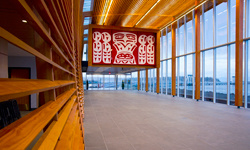
Project location: Nanaimo Regional District
The Nanaimo Port Authority has completed a brand new cruise ship docking facility thanks to a financial contribution from the Infrastructure Stimulus Fund.
Prior to its construction, cruise ship operators had to shuttle their passengers to and from the harbour area by boat, which caused inconvenient delays for visitors to the West Coast.
The new floating dock is nearly 100 metres long and 15 metres wide and maintains a deck height of two metres above the waterline. It is the only facility in the Pacific Northwest big enough to handle the largest of west coast cruise ships.
Workers also constructed a new welcome centre as part of the project. It includes customs and immigration facilities for the Canada Border Services Agency, as well as a lounge and receiving area for visitors.
The Nanaimo Floating Cruise Ship Terminal provides a new point of access for tourists wanting to visit the North Gulf Islands, and the west-coast Pacific Rim National Parks. Within the next five years, Port Authority officials hope it will attract about 25 to 30 vessels annually carrying approximately 3,000 passengers each. The economic impact of the visiting ships is expected to be $170,000 to $200,000 per visit.
The terminal is providing a much-needed boost to the area's tourism industry. Its construction also brought jobs to the area for local construction workers.
Federal contribution: $8,500,000
Improving urban recreational opportunities

Project location: Nanaimo Regional District
The Meadow Drive Community Park is located between the neighbourhoods of East Wellington and Pleasant Valley in the Regional District of Nanaimo. Built on four acres of partly forested land, the park includes an accessible playground, a sports field, wheelchair friendly trails and fitness activity stations.
With infrastructure funding from the provincial LocalMotion program, the Government of Canada's Infrastructure Stimulus Fund, and the municipality, the new park was built to encourage outdoor family activity. Regional District staff invited local residents to participate in the park's design. Through surveys, an advisory committee and an open house, interested residents were consulted during the project's development.
"The Meadow Drive Community Park is really appreciated for its children's playground equipment and the paths that have been constructed,"
commented Regional District Director, Maureen Young. "It has become a real focal point for residents."
The new park, which offers users of all ages a wide variety of activities, is sure to remain a source of community pride for years to come.
Federal contribution: $18,495
Modernizing municipal facilities

Project location: New Denver
The Village of New Denver is located on the shores of Slocan Lake in the West Kootenay region. It is one of several small lakeside communities built along 19th century silver mining routes where residents enjoy stunning panoramic views and abundant outdoor recreational opportunities.
In recent years, the community's municipal office and public works facility had become too small to meet its growing needs. Accessibility and energy efficiency were also an issue.
Thanks to financial support from the federal government's Infrastructure Stimulus Fund, the facility is now nearly double the size and wheelchair accessible. It boasts state-of-the-art solar and geothermal heating systems, low flow water fixtures, a new septic system, and energy efficient doors and windows for significant energy savings.
"The funding for this program couldn't have come at a better time for us,"
remarked New Denver Mayor, Gary Wright. "It allowed us to significantly upgrade the village's major municipal building in ways that will provide major energy savings in the future and provide employment to local contractors and suppliers. On top of that, it was delivered with a minimum of
'red tape'
and a great deal of understanding at the federal and provincial levels."
Federal contribution: $139,994
Highway 17 interchange

Project location: North Saanich
Highway 17 is the principal north-south corridor on British Columbia's Saanich Peninsula. The Economic Action Plan's Infrastructure Stimulus Fund is making a new interchange possible that will include major improvements to the public transit facilities, including an expanded park and ride area, transit exchange and Rapid Bus service. The interchange will use a roundabout system to help minimize infrastructure costs and property buyouts.
The project is expected to improve road safety, reduce collisions, improve commute times and better accommodate cyclists and pedestrians. It will also improve access to the Victoria International Airport, BC Ferries and the local road network.
Reduced idling from stop-and-go traffic, along with greater public transit use means more efficient energy use and better air quality because of reduced emissions.
"The Victoria Airport Authority is very pleased to join with our federal and provincial governments by helping to fund a project that will solve the safety and congestion problems at this critical intersection,"
says Richard Paquette, former President and CEO of the Victoria Airport Authority.
Federal contribution: $10,500,000
Improving traffic efficiency
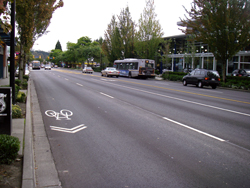
Project location: North Vancouver
Marine Drive is a major transportation route serving the North Shore region of Greater Vancouver, but an aging road surface and heavy traffic congestion had increased the risk of accidents. The lack of dedicated bicycle lanes meant concern for cyclists.
To address these issues, the Government of Canada joined with the province and municipality to contribute one third of the costs through the Infrastructure Stimulus Fund.
The road surface has been replaced with a new material that is less susceptible to rutting and performs better than traditional materials. A bicycle lane connects cyclists with the existing North Shore cycling network, and buses-only lanes further encourage people to use alternate means of transportation.
A new traffic signal system allows the city to monitor traffic data in real time, and the timing of traffic signals has been further co-ordinated to improve commuting times. The system also helps manage traffic incidents and extracts the data needed to fine-tune the system and plan for the future.
More efficient traffic management means less greenhouse gas emissions and fewer logistical problems along a major artery serving thousands of suburban residents every day.
Federal contribution: $443,334
Buick Creek Arena construction – done

Project location: Peace River Regional District
The residents of Buick, a town in the Peace River Regional District, had wanted a local indoor ice arena and recreation facility for some time. With support from the Government of Canada's Recreational Infrastructure Canada (RInC) program and Infrastructure Stimulus Fund (ISF) program, this dream has become a reality.
The whole region is now enjoying a National Hockey League-sized ice arena housed within a brand new building. The facility features heated change rooms, service and storage rooms and concession space. The building is also accessible to people with disabilities. Hockey, figure skating, broom ball and public skating can now get underway for the winter season, while volleyball, floor hockey and indoor soccer are available from May to October. The recreational facility also can now provide a venue for community gatherings and social events.
"We have a plan to move our community forward into the future,"
said Karen Goodings, District Chair. "These investments [have] really helped us achieve our goals."
Federal Contribution: ISF: $200,000; RInC: $946,267
Safeguarding public health and the environment
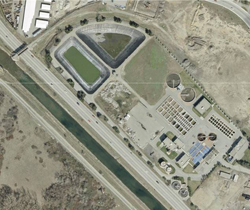
Project location: Penticton
Nestled between Okanagan Lake and Skaha Lake, Penticton lies in an ecologically sensitive area. With the Okanagan River channel passing through town, having a safe and effective wastewater management system is an important consideration in this part of the province.
Thanks to financial support from the federal Gas Tax Fund, major upgrades are now complete at Penticton's wastewater treatment plant. The plant can now process 50 per cent more waste and uses three overarching treatment processes instead of one. More than half a dozen filtration and disinfection methods are also now used to treat the wastewater, including innovative techniques like ultraviolet light disinfection. This higher quality effluent is being used to irrigate three of the largest parks in the City.
Adding to the improvements is state-of-the-art technology that captures methane to fire a micro-turbine, which generates electricity to power the plant. Heat energy is also being captured to heat the plant and create the potential for supplying a district heating system for nearby commercial and industrial operations.
This project has helped ensure the City of Penticton can continue providing high-level sewage treatment services to current and future residents in a more sustainable, cost-effective way.
Expanded water and sewer systems support green development
Project location: Port Alice
The Village of Port Alice, located on the banks of Vancouver Island's Neroutsos Inlet, is known for its natural beauty and salt water fishing.
Preserving this pristine environment is a priority for the community, as well as increasing its potential for growth. Two projects financed by the federal government's Gas Tax Fund have helped the community advance these goals.
For the first project, workers expanded water and sewer services to accommodate the Copper Coast Subdivision and increase capacity for future development. The Copper Coast Subdivision was completed in 2010 and includes resort units to draw more tourists to the area.
The Village also used Gas Tax funding to decommission a sewer lift station that serviced the Alderwood Acres Mobile Home Park. Mobile park residences are now serviced through an adjacent lift station, which is reducing overall operating and maintenance costs for the community.
These water and sewer projects have improved residents' quality of life while supporting economic development in the region. Putting more sustainable water management in place has also helped the village bring its plans for development into line with its environmental priorities.
Port Alice Community Centre renovation

Project location: Port Alice
The Village of Port Alice, on British Columbia's Vancouver Island, received $545,500 under the Economic Action Plan for much needed renovations to its aging and water-damaged community centre.
An energy audit revealed that the building was not energy efficient and needed many repairs. The centre serves the Village's citizens in many ways, including School District No. 85 for gym classes, the Regional Library, the Lions Club, wedding receptions, company parties, memorial services, civic celebrations and municipal meetings.
Worker replaced the roof, repaired water-damaged walls and retrofitted the centre for energy efficiency.
"The Village of Port Alice is a single-industry community that is struggling financially,"
said Gail Neely, Mayor of Port Alice at the time of the project's announcement. "This funding opportunity relieves tremendous financial pressure and will benefit the entire village."
Federal contribution: $545,500
Infrastructure improvements contributing to inter-community relations

Project location: Port Renfrew
Nestled on the West Coast of Vancouver Island and administered by the Capital Regional District, Port Renfrew is about an hour's drive from Victoria and home to a population of just under 200 residents. Although its history boasts exciting tales of sailors and shipwrecks, today the town is more famous for its salmon fishing.
Thanks to support from the federal Infrastructure Stimulus Fund, Port Renfrew renovated its community centre and fire station. The funding went towards an energy refit of the Community Centre, as well as an interior retrofit of the attached fire station.
The community centre replaced its roof, doors, windows and insulation, and installed a new heat recovery ventilation system.
The project made use of sustainable energy sources by installing a new ground source heat pump and solar hot water system that increases the energy efficiency of both buildings. A new back-up power supply helps sustain operations during electrical service interruptions.
Designed to reflect West Coast aboriginal culture, the fire station features cedar logs donated and prepared by local Pacheedaht First Nation builders.
This project delivers many regional benefits. Besides allowing the community centre to expand its programming to enhance inter-community relations, the fire hall now serves as a base for fire fighting in both Port Renfrew and Pacheedaht First Nations.
Federal contribution: $173,333
Working together
Improving public safety
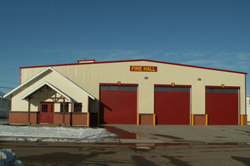
Project location: Pouce Coupe
Pouce Coupe, a village in British Columbia's Peace River district, really needed a new fire hall. The old facility lacked the space for equipment and multiple fire engines; training facilities for the town's 20 volunteer fire fighters were also inadequate, and emergency response obligations were on the rise.
Mutual assistance agreements with nearby Dawson Creek and Toms Lake also emphasized the importance of having an up-to-date, well-trained fire department.
With the help of $200,000 in federal assistance from the Infrastructure Stimulus Fund, Pouce Coupe built and opened a new fire hall in 2009. It now houses the village's two pumpers and one tanker, and provides training facilities for volunteers.
Pouce Coupe Mayor Lyman Clark calls it a "spectacular project"
that emphasizes the importance of working together. "With the provincial and federal governments backing us, we have a plan for moving our community ahead…with even more strength and more opportunities for our residents than ever before."
Federal contribution: $200,000
Federal Gas Tax Fund helps community cut energy costs

Project location: Prince George
Many northern communities are built around heavy industry or harvesting natural resources. Rising energy costs are a common concerns in these towns and villages.
In Prince George, an innovative new program known as the District Energy Sharing System is being used to address this challenge. Seven downtown buildings are harnessing excess thermal energy produced at the nearby Lakeland Mill, thereby reducing their dependency on fossil fuels.
Through this system, water is heated at the mill using leftover wood pulp waste that would otherwise have to be trucked off-site. The hot water is then piped underground, where it circulates to the Civic Centre, Coliseum, City Hall, a hotel pool, the library and the Two Rivers Art Gallery. High-efficiency heat exchangers in these buildings then extract the energy needed for heating and hot water.
This technology saves these facilities from having to own and operate large, expensive boilers. By using a sustainable and inexpensive energy source, their fuel costs are being reduced along with their environmental impact.
New emission control features were also installed at the mill as part of the District Energy Sharing System project. Combined with a reduction in the use of heavy-duty diesel trucks used to transport the excess wood pulp, the mill now has a smaller ecological footprint as well.
This project was made possible, in part, by financial support from the federal Gas Tax Fund. To reduce harmful greenhouse gas emissions, variations of this low-cost, energy-saving system are being adopted in many cities across Canada and around the world.
Improving transportation routes in the North

Project location: Prince George
In many areas of BC's interior, narrow bridges and low overpasses make the movement of oversized goods challenging. Companies transporting construction cranes, pre-fabricated buildings and machinery important to the mining, forestry and energy sectors are often forced to find alternate, longer routes.
The two-lane Stone Creek bridge located between Prince George and Quesnel had served the Cariboo Highway for over 50 years, but had increasingly become a source of traffic bottlenecks along this important corridor.
With a financial contribution from the Government of Canada's Infrastructure Stimulus Fund, the Town of Prince George replaced the old bridge with a new four-lane structure. Workers also widened 1.5 kilometres of Highway 97 to match an earlier four-lane highway expansion south of the bridge.
Residents and businesses now enjoy increased road safety and load capacities, and shorter travel times.
Projects like these are improving the lives of citizens across northern Canada. Easier access to some of Canada's more remote areas is great for tourism and the flow of goods throughout the region. That's good for businesses, and keeps the area's mining, forestry and energy industries competitive.
Federal contribution: $13,000,000
Sharing the benefits of electric transportation
Project location: Prince George
In Northern BC, the City of Prince George is using a partnership approach to reduce greenhouse gas emissions.
The City developed a vehicle-sharing agreement with the Fraser Fort George Regional District, the regional health authority and the University of Northern British Columbia. The four organizations will operate a new electric car for three months of each year to help raise awareness about the technology and demonstrate their environmental commitment.
The City of Prince George used part of their federal Gas Tax Fund allocation to purchase an electric vehicle and four charging stations – one for each partner's site. Each partner will cover their own insurance and their share of the vehicle maintenance costs. While producing zero emissions, the car will save the participating organizations about $3,000 per year in operating costs compared to their existing gasoline and diesel-powered vehicles.
By providing the necessary infrastructure and drawing attention to the availability and practicality of these vehicles for commercial use, the hope is that other local organizations and businesses, as well as private citizens, will adopt the technology.
With the potential for improvements to both air quality and bottom lines, we might see more of these vehicles on the road in the years to come.
Reviving downtown core
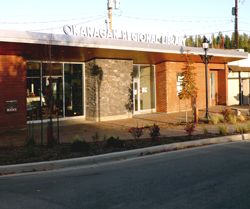
Project location: Princeton
Thanks to the federal Infrastructure Stimulus Fund, a recently refurbished building in the heart of Princeton's downtown commercial district has become the new home of the Okanagan Regional Library.
The project improved the energy efficiency of the building structure and systems, added more computer workstations and created a multi-purpose room for meetings and events. The new facility is also fully accessible to people with disabilities and provides high-speed Internet access, something that wasn't available before the move.
Mayor Randy McLean sees the move as a much-needed economic boost for the town. Not only have library services been expanded and enhanced, but construction and the need for more library staff have boosted employment. He also sees a tourism connection as expanded public access to the Internet at the Library brings visitors to the commercial centre of town.
Federal contribution: $199,499
Community improvements finished in Qualicum Beach

Project location: Qualicum Beach
A British Columbia town has completed two projects, funded through the Infrastructure Stimulus Fund. Located on the sheltered eastern shores of Vancouver Island just 40 kilometres north of Nanaimo, Qualicum Beach enjoys the quality of life and economic benefits derived from investing in their scenic surroundings.
Using $237,500 in federal funding contributions, the town has completed construction on a traffic-calming roundabout with landscaped medians and improvements to an important community trail system.
The second project, a comprehensive school connector trail, forms the spine of the town's cycling/walking trails. Both projects, worth an estimated $837,000, have improved traffic flow and safety for residents and visitors.
Federal contribution: $237,500
Improving forest service roads in BC's interior
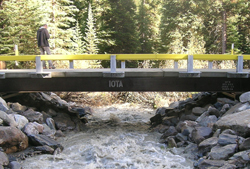
Project location: Radium
Radium Hot Springs is a village of approximately 800 people named for the hot springs located in nearby Kootenay National Park.
Many of the bridges in this area were built decades ago, primarily using local timber. With a life expectancy of only a few decades, a number of them are now past their prime, including two along the Horsethief Creek forest service road. The road provides access to pristine forest land east of Radium Hot Springs and is regularly used by logging trucks, industrial vehicles and local residents.
Thanks in part to a contribution from the Government of Canada's Infrastructure Stimulus Fund, these two aging structures have now been replaced. The new concrete bridges are much more durable and include modern safety features to help prevent accidents. They are also set farther back from the river banks to reduce disruptions to water flow or aquaculture.
Bridge replacement projects like these are helping to improve people's access to many popular recreational and eco-tourism sites across the region.
Federal contribution: $82,500
New waste management facilities

Project location: Regional District of Mount Waddington
The Regional District of Mount Waddington is located on the pristine northeast coast of Vancouver Island. The District administers many public services for Woss, Winter Harbour and Malcolm Island, such as transit, parks management and waste management. Managing the disposal of household goods in three of the region's more remote communities, however, was a challenge.
Thanks to the federal Gas Tax Fund, the District now has a one-stop recycling facility that can handle over 40 different types of items, from televisions to household chemicals.
"Having the Gas Tax money was vital to getting this problem fixed as Woss could not afford to build this structure on its own,"
said Dave Rushton, Director of the Mount Waddington Regional District.
Designated waste management facilities are essential to preseving the environment and a high quality of life for residents. The Region can now manage its waste much more effectively over the long term, helping reduce environmental impacts and preserve the natural beauty of the area.
Protecting the environment through waste management initiatives
Project location: Regional District of Okanagan-Similkameen
Many British Columbians choose to live in outlying villages and towns instead of large urban areas.
The Regional District of Okanagan-Similkameen, located in south-central British Columbia and spread over 10,000 square kilometres, has a rapidly growing population of over 80,000 people. Its ongoing construction and development, combined with long distances between disposal sites, makes solid waste management an important issue.
With financial help from Canada's Gas Tax Fund, the District developed a regional Solid Waste Management Plan. The development process helped assess current disposal systems and determine the most sustainable way to keep pace with residential growth.
Planners learned that recyclable and organic materials from commercial buildings, multi-family dwellings and construction sites were generating the most landfill. This information led to the launch of new recycling initiatives for businesses and food waste collection from residents. These programs are expected to significantly reduce the amount of solid waste being transported to landfills.
This project is an example of how the federal Gas Tax Fund works at the local level to help communities achieve positive environmental results while addressing pressing public infrastructure needs.
Smart city planning
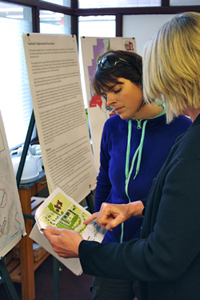
Project location: Revelstoke
The City of Revelstoke used financial support from the federal Gas Tax Fund to implement an innovative approach to community planning that will result in a Unified Development Bylaw, one of the first to be used in Canada.
The bylaw will support the sustainability principles adopted under the City's Official Community Plan, including the decentralization of Revelstoke through the creation of several neighbourhood centres.
One of Revelstoke's goals is to plan a series of walkable neighborhoods, integrating residential, office and retail development with room-like public spaces and pedestrian-oriented transportation.
This new community-planning approach uses visual images that clearly demonstrate what kind of development is allowed. This makes it easier for residents to participate in the City's planning process. It also makes it easier for developers to better integrate and align private residential development with community priorities.
Easing traffic congestion

Project location: Richmond
Improving traffic flow and reducing congestion is an ongoing challenge for many growing communities. The City of Richmond is no exception.
Recent construction of Olympic facilities, such as the Olympic Oval, and the new Bridgeport Station on the Canada Line – a public transit line – has increased local traffic. To enhance traffic flow, access along Lansdowne Road towards Vancouver International Airport on Lulu Island needed to be improved.
Thanks to a federal contribution from the Infrastructure Stimulus Fund, Lansdowne Road has been extended. In addition to providing better bridge access, this new stretch of road is making it easier for people to use the Canada Line as a direct link to Vancouver and the rest of the lower mainland. This is improving travel times for visitors, commuters, and residents alike.
Other elements of the project included the addition of high-efficiency lighting, geothermal sidewalk warmers to reduce annual maintenance costs, and bike lanes to increase safety for cyclists.
"This passage is an important link in our transportation network,"
explained Richmond Mayor Malcolm Brodie."It will encourage transit and pedestrian use with new bicycle lanes, street lighting and sidewalks."
Federal contribution: $666,666
Harnessing renewable wastewater energy

Project location: Saanich Peninsula
A project in the Capital Regional District of British Columbia that received financial support from the federal Gas Tax Fund is attracting attention by turning wastewater effluent into a productive energy source.
The Saanich Peninsula Wastewater Treatment Plant is now more environmentally sustainable thanks to several innovative technologies that allow the plant to create thermal energy. Heat pumps, exchangers and coils are being used inside the plant to create energy, and micro-turbines have been installed to harness energy from the flow of treated effluent as it leaves the plant.
This energy is being used to heat the plant itself, as well as other nearby buildings, such as the public pool at Panorama Recreation Centre and an elementary school. Officials with the Capital Regional District expect these techniques will result in net energy savings of up to $77,000 a year.
"The federal Gas Tax Fund is playing a vital role in supporting innovative technology to reduce greenhouse gas emissions produced by local government operations,"
commented Barbara Steele, President of the Union of British Columbia Municipalities at the time of the project's announcement. "The Capital Regional District is to be applauded for developing this project to utilize waste heat from its treatment plant."
Preparing for growth
Improved water supply

Project location: Squamish
Recent development in Squamish, and the anticipation of more growth to come, prompted city officials to examine potable water supplies and demand. They were already near capacity but, at times, surface water had to be used to supplement groundwater sources.
The city, located about half way between Vancouver and Whistler, was also experiencing problems meeting peak water demands. Now, with $475,000 from the federal Infrastructure Stimulus Fund, the city has positioned itself to meet growth demands.
Squamish used the funds to build a new water station to bring the municipal pumping system up to current energy efficiency and environmental standards. Squamish Mayor Greg Gardner calls it a "critical piece"
of the city's water network. The upgraded pumping station also ensures the city is prepared for future growth.
Federal contribution: $475,000
Federal Gas Tax Fund helps improve traffic management
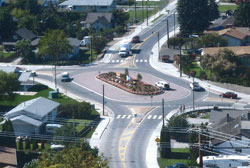
Project location: Summerland
The Town of Summerland has replaced the 4-way stop at the intersection of Prairie Valley Road and Victoria Road with a roundabout that is helping ease congestion along the community's busiest thoroughfare.
One of four recently built to improve traffic flow in the area, the new roundabout offers a greener alternative that is improving safety for all road users. By reducing stops and starts, as well as vehicle idling, traffic circles help reduce carbon emissions while keeping traffic moving through the intersection. Vehicles also move slower through a roundabout, further reducing the risk and severity of accidents.
New sidewalks, crosswalk islands and roadway markings will contribute to pedestrian safety. A garden in the centre of the traffic circle adds visual appeal, as does the addition of pavers to create a buffer area between the cars and garden.
The District of Summerland used funding from the federal Gas Tax Fund and the Insurance Corporation of BC to complete the roundabout.
"This project will reduce congestion on the busiest corridor through Summerland,"
said Summerland Mayor Janice Perrino. "This project will provide a safer environment for all and improve traffic movement through the central part of our community."
The addition of this traffic calming measure has improved pedestrian safety and traffic flow, while reducing accident risk and vehicle emissions — a winning strategy for everyone.
Improved energy efficiency and community resources
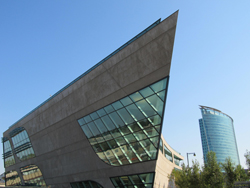
Project location: Surrey
Surrey's new City Centre Library is an important addition to the City's developing downtown core. It accommodates a wide variety of community needs. With three times the space of the City's former main library, it houses more than 100,000 publications, administration offices, group study areas and a coffee shop.
The building has a striking nautical design, is equipped with the latest technology and has more than 80 public computer stations. The facility boasts three community meeting rooms, a large children's section, a computer learning centre, a teen lounge and a gaming area.
City Centre Library offers diverse programming and acts as a satellite campus for Simon Fraser University's Continuing Studies Department. It is fully accessible to people with disabilities and provides extensive material in alternate formats.
The innovative design of the library is matched only by its LEED-certified energy-saving capacities. For example, the building has Surrey's first "green" roof, which is designed to avoid absorbing direct sunlight, thereby reducing cooling costs.
"Our new library has already become a wonderful community gathering spot and is attracting visitors from all across the region, creating a new cultural and social hub in the city,"
said Mayor Dianne Watts. "I believe that innovative and unique architecture has the ability to shape a city's identity and create the heart and soul of a community."
Federal contribution: $10,000,000
Protecting water supplies during power outages
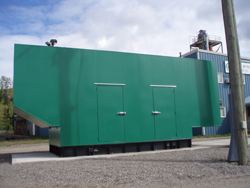
Project location: Terrace
The City of Terrace can be found on the banks of the Skeena River, sheltered between the coast and the Hazelton Mountains. Its prime location creates a natural greenhouse effect, resulting in a landscape rich with orchards and specialty crops.
Until recently, Terrace relied upon an unreliable treatment system to disinfect water from back up sources during power outages. The community's emergency system used two surface water sources using only chlorine as a water disinfection process.
With support from the federal government's Infrastructure Stimulus Fund, Terrace addressed concerns by installing an automated back-up power supply for the city's three water wells, including a dedicated fuel tank and automated power transfer switch.
These improvements mean the community's 11,000 residents can enjoy a continuous supply of safe drinking water – even during an electrical power outage.
Federal contribution: $149,143
Revitalizing a building – and a community
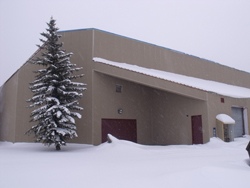
Project location: Tumbler Ridge
The community centre in Tumbler Ridge, a small town in northern British Columbia, promotes activity for everyone in the area. Its facilities include an aquatic centre, indoor playground, rock-climbing wall, squash and racquetball courts, aerobics and fitness gym, skating and curling rinks, museum, art gallery and licensed lounge.
Built in the 1980s, the centre was beginning to show the strains of heavy use and time. It was time for a retrofit.
Work is now complete on revitalizing Tumbler Ridge's community centre; $200,000 from the federal Infrastructure Stimulus Fund, together with provincial and municipal funding, paid for new doors and windows, and replaced the exterior insulation finish system.
By bringing new vitality to a building used by so many residents of the area, municipal officials anticipated a boost to community spirit. At the time of the announcement, Mayor Larry White said the work was vital to maintaining one of the most valued buildings in town: "For almost 30 years the community centre has served us well. We anticipate that, that with the retrofit, the facility should be good for another 30 years."
Federal contribution: $200,000
Improving fire-fighting capacity

Project location: Valemount
Skirting beautiful Mount Robson Provincial Park, Valemount is a peaceful little town near the provincial border.
Despite its population of just over 1,000 residents, the citizens reap the benefits of a community that invests into infrastructure that contributes to a high quality of life. Excellent roads, a municipal sewer system, high quality communications infrastructure, medical and college services, plus an amazing array of outdoor activities in the area are all at their disposal.
In keeping with this approach, Valemount upgraded its potable water distribution system while it was completing a separate downtown revitalization project. Doing the work concurrently also reduced excavation costs dramatically.
With support from the federal Infrastructure Stimulus Fund, there were over 600 metres of new water mains installed, along with three new fire hydrants. The new water mains are larger to accommodate future density increases on 5th Avenue, with about one-third replacing outdated pipes constructed from asbestos cement. The new water mains have greatly improved water flow and fire fighting capacity.
Federal contribution: $87,267
Improved commuter services

Project location: Vancouver
The Major Infrastructure Component of the Building Canada Fund helped the West Coast Express commuter rail service meet the demand for urban public transit in metro Vancouver.
With a fleet of state-of-the-art trains and highway coaches, West Coast Express serves commuters in Vancouver and suburban Mission, Port Haney, Maple Ridge, Pitt Meadows, Port Coquitlam, Coquitlam and Port Moody. At the Waterfront station in Vancouver, passengers can transfer to other modes of public transit serving the region.
To meet the increasing demand for service from suburban commuters, West Coast Express purchased seven additional rail cars and made upgrades to Vancouver's Waterfront station and the station in Mission. Longer platforms in both stations improve passenger access and safety, and better accommodate the longer trains. Additional security cameras were also installed.
TransLink operates the commuter rail service for West Coast Express. Dale Parker, Chair of TransLink, pointed to extensive up-front planning as having been a key element in the agency's ability to attract the support of all levels of government for this project and make the upgrades as quickly as possible.
Federal contribution: $9,019,000
Shoring up historic seawall and lighthouse
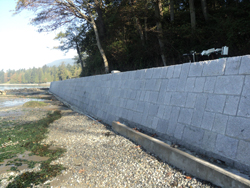
Project location: Vancouver
Three sections of Stanley Park's historic seawall have received a facelift to help protect the popular pathway from high tides and severe weather, and smooth the way for pedestrians and cyclists.
Old masonry sections were replaced with a granite-faced concrete seawall at Second Beach. The pathway was also repaved between Lumbermen's Arch and Brockton Point.
The historic Brockton Point Lighthouse is an integral part of the seawall, so the project also included replacing its retaining walls and railings. The upper portion of the lighthouse had already been rebuilt in 2007.
The completed project increases protection against storm surges and will reduce long-term maintenance costs. It has also greatly improved the experience for the park's 2 million annual visitors.
The City of Vancouver and the Government of Canada shared the costs of the upgrades. The federal funding was delivered through the Infrastructure Stimulus Fund.
Federal contribution: $2,000,000
Improving parks, promoting tourism
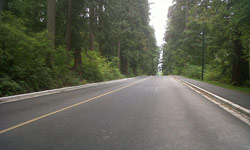
Project location: Vancouver
As one of the marquee tourist attractions in the province, Stanley Park receives an estimated 8 million visitors each year, most arriving by public transit, private vehicle or chartered bus.
Such heavy use of the two narrow lanes of road encircling the park has caused some major deterioration over the years. With a limited budget, the Parks Board responsible for maintaining this roadway had trouble keeping it up to city standards.
With a successful application to the federal government for Infrastructure Stimulus funding, the Board has now been able to mitigate this problem by rehabilitating 1.8 kilometres of Pipeline Road and sections of Stanley Park Drive. These improvements are not only providing drivers and visitors with a smoother ride, but also helping reduce noise pollution and maintenance costs.
This project dovetails nicely with other Stanley Park projects receiving federal funding, including improvements to the fieldhouse, seawall, and the Malkin bowl. "We worked hard to get these projects shovel-ready,"
remarked Vancouver Mayor, Gregor Robertson, "and we look forward to completing them on time."
Federal contribution: $1,500,000
Supporting the intersection of tourism, education and marine conservation in Vancouver

Project location: Vancouver
The Vancouver Aquarium has been a flagship tourist destination in the heart of Stanley Park since 1956. Over the decades, it has undergone several expansions and is now the largest aquarium in Canada, hosting about one million visitors annually.
The organization promotes marine conservation, education and research. To further these objectives and enhance the visitor experience, a significant revitalization of the facility is now under way.
Once complete, a striking new entrance pavilion and outdoor plaza featuring indigenous west coast vegetation will introduce people to the exhibit areas. The BC Wild Coast exhibit space is also being expanded.
Equally important, if not visible to the public, are essential updates to mechanical, water filtration and electrical systems. State-of-the-art energy-conserving heating and cooling systems will be installed to bring the building up to the gold standard for Leadership in Energy and Environmental Design (LEED).
The Vancouver Aquarium is dedicated to connecting people to the natural world and making significant contributions to scientific development. The facility upgrades will help ensure that future generations of students, teachers and researchers can continue to enjoy the important programming and inspiring environment this institution provides.
Federal contribution: $15,000,000
Encouraging fresh-air commuting
Going green, getting healthy
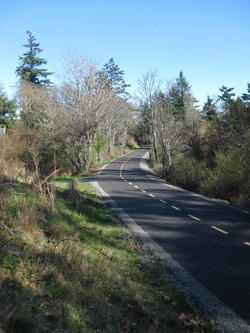
Project location: Victoria
Funding of $137,693 helped the Capital Regional District of Victoria upgrade a major commuter corridor on lower Vancouver Island that also happens to be part of the Trans Canada Trail – a coast-to-coast system of linked paths in Canada.
Named for a noisy, awkward-looking rail-car system that carried passengers in the 1920s between Sooke and Victoria, British Columbia, the Galloping Goose Trail is a 55-kilometre multi-use recreational path linking urban, rural and wilderness settings.
Cyclists, joggers, rollerbladers and residents out for a stroll take advantage of the Galloping Goose to get to work or simply enjoy the enveloping greenery of the trail.
With an estimated 220,000 cyclists alone using the Galloping Goose each year, many on their way to and from work, concerns had been raised about the safety of the trail's sometimes rough surface. Funds were used to pave part of the Trail to improve travel quality and promote increased use, thus getting more greenhouse-gas-emitting vehicles off regional roads.
Christopher Clausen, Capital Regional District Parks Committee Chair sees the newly paved surface as a huge encouragement to get people out in the fresh air and drivers out of their vehicles and onto a bike. Fewer vehicles in transit mean cleaner air and an improved environmental quality of life. It's a win-win situation for the health of the community and its residents.
Federal contribution: $137,693
Improving traffic congestion and transit service

Project location: West Vancouver and District of North Vancouver
The Old Capilano "Blue" Bridge, which carried two lanes of traffic westbound between the Lions Gate Bridge and Taylor Way, has been replaced with a three-lane structure to relieve congestion along Marine Drive. Rehabilitating the old bridge would have been too costly due to extensive corrosion, lead paint and traffic management in the midst of work crews.
Thanks to $18 million from the federal Infrastructure Stimulus Fund, work began in the summer of 2009 with the construction of temporary abutments in the Capilano River. Gas, electricity and telephone lines crossing the river on the old bridge had to be capped and utilities rerouted so there would be no interruption in service. The significant pedestrian and bicycle traffic on the bridge also required a detour.
In June 2010, the existing bridge was moved onto the new abutments and temporary approaches completed to the realigned bridge, which served as a detour while the new bridge was under construction.
The new bridge was opened to traffic in the spring of 2011. It includes a third lane for transit services and accommodates pedestrian and bicycle traffic. The buses-only lane has improved service to and from downtown Vancouver for riders of the 12 bus routes currently using the bridge.
Federal contribution: $18,000,000
Supporting active living
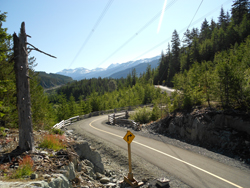
Project location: Whistler
Many of Whistler's neighbourhoods are linked by a network of off-road trails and corridors. These pathways provide an alternative to Highway 99 for cyclists, hikers, pedestrians, in-line skaters and others who don't feel safe sharing the road with fast-moving highway traffic.
The Sea-to-Sky Highway was the only paved route between Spring Creek and Function Junction at the south end of Whistler. This forced many recreational groups onto the provincial highway.
With funding from the federal Infrastructure Stimulus Fund, the ActNow BC initiative and the Resort Municipality of Whistler, a new 900-metre section of trail between these two communities is now available. This project completes the paved link between Whistler Village and the Sea-to-Sky trail south of the town.
In addition to promoting physical activity, the three-metre-wide Valley Trail provides a safe transportation alternative for the many residents and visitors to Whistler who enjoy taking advantage of British Columbia's natural beauty.
Federal contribution: $187,500
Having fun in a safe environment

Project location: Williams Lake
With a population of more than 25,000, Williams Lake, in British Columbia's central interior, is home to many young families whose children really appreciate the play spaces in the city's municipal parks.
One older park in the downtown core of Williams Lake needed some refurbishment. Much-used play structures were showing their age, and access for persons with disabilities was an issue. To refresh the park and improve accessibility, Williams Lake successfully applied to the Infrastructure Stimulus Fund for assistance.
Work included a new, accessible play structure and swings set on a rubberized ground surface to improve safety. An interior walkway opens up the park even further.
Chief Administrative Officer Brian Carruthers points to the exciting possibilities of the new playground, "Children of all abilities can now interact in a fun and safe play environment that allows them to participate to their highest potential."
Federal contribution: $70,000
- Date modified: